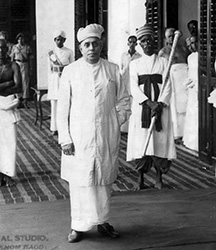
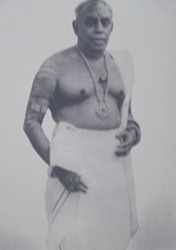
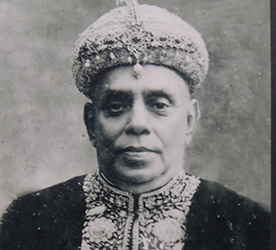
The story of Pareekshith is from the epic Mahabharata. During the war between Pandavas and Kauravas, Ashwathama fighting for the Kauravas against the Pandavas had taken a vow to annihilate the whole Pandava clan including the ones who were yet to be born. The clan was getting annihilated and the only surviving life was in the womb of Uttara, wife of Abhimanyu, son of Arjuna. Ashwathama fired a powerful Brahmastra aimed at destroying the growing embryo in Uttara’s womb. But Lord Krishna by divine intervention blocked the Brahmastra and so was Pareekshith born.
As a child, Pareekshith Thampuran was prodigious. Initial tutoring was by his mother followed by tutoring by the famous Sanskrit scholar known as Abdicated Highness. His scholastic achievements were enumerated by Vrinda Devi Thampuran. He was awarded the A.F Sealy award for the first in Arts examination at Maharajas College, Ernakulam. He finished his B.A from Presidency College, Madras. His knowledge in various fields including Science was remarkable. Even during his old age, he continued to be an ardent student.
He married Sreemathy Ammukutty Amma from the Ittianath family. She was the step-daughter of the Abdicated Highness. They had no children. As son-in law of the Abdicated Highness, he was well groomed to be a great Statesman. But the winds of change altered the course of history for the Cochin Royal Family forever. H.H Rama Varma was the last Maharaja of Cochin until the United States of Travancore and Cochin was created in 1949 by the Government of India. His predecessor had already given his Ministers and the Legislature all the power to rule. One hundred years of Dewan’s tradition had been discontinued. H.H Rama Varma had no Dewan when he became the Raja. He was a figure head presiding over the elected Government.
V.P Menon, the Secretary of Sardar Vallabhai Patel, who was the Minister of States in the Nehru Government , was despatched to Travancore and Cochin to effect a union of the two States as it was the most expeditious move to do. The idea of Akya Kerala that was put forth by the previous Raja, Kerala Varma , was shelved. Talks with Travancore proved difficult and somewhat contentious. The then Dewan of Travancore, C.P Ramaswamy Iyer led the discussions. Maharaja of Cochin was kept appraised of the implications of all developments. Since the public opinion was favourable to integration, he had no difficulty with the envisaged process. To end a dynastic continuity, a tradition of being the Ruler for many hundreds of years, and to forsake the responsibility of his subjects distressed him. This the iron hand of Sardar Patel was not hesitant to brush aside.
The Maharaja of Travancore requested that he be the Rajapramukh for life, though he preferred ‘ Peruma l’ ! The other objection he had was the difficulty to take the oath of office as the head of the State, since he ruled the State not as a head but as a servant of the tutelary deity Sri Padmanabha. The Government of India did not commit themselves to any promise. Ultimately the Maharaja agreed to tender an oath generally taken by Governors..”that he would be faithful to the constitution of India and the new union.”
The Maharaja of Cochin made practically no demands at all. He agreed to retire in favour of the Maharaja of Travancore. This spirit of selflessness was the core of Rajas of Cochin for centuries!
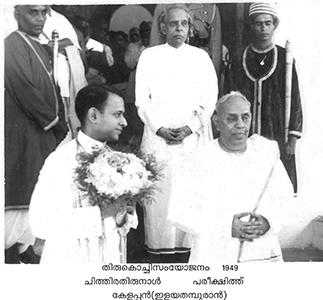
Chithira Thirunal of Travancore and Pareekshith Thampuran of Cochin - 1949 - Formation of the United States of Travancore and Cochin
Privy purse of Rs 2,35,000 was fixed for the last Raja of Cochin. The ruling family consisted at that time of 233 Princes, and 231 Princesses, all of whom were getting an allowance from the State. This was continued.
V.P Menon wrote the book “ The story of the integration of the Indian States”. It was a personal narration, a perspective and needed no corroboration. It certainly was valuable historically. I am compelled to present a slightly different perspective after reading and listening to Mr. Elamana Hari who is an octogenarian living in Tripunithura. Signing of the famous document for integration of Travancore and Cochin and to join the Indian Union took place in the Hill Palace. Hari was in his early twenties and worked under the Private Secretary of the Maharaja and was present there. He described the whole scene the following way.
The event took place in the Durbar Hall in Hill Palace Tripunithura. V.P Menon and others including Prime Minister Ikkanda Variyar were already in the adjacent foyer. His Highness Maharaja Pareekshith Thampuran accompanied by his usual courtiers , Private Secretary, and Superintendent Elamana Hari entered the Hall , followed by V.P Menon and others. Hari noted that Mr. Menon was a chain smoker and threw away a half smoked cigarette before he entered the Chamber. There on a table was kept a lighted lamp, the traditional Vilakku, and a silver bowl of coins. Maharaja went straight to the table and meditated for a few minutes in front of the lamp, slightly touching the bowl. The occasion was profound and there was an eerie silence. Mr. Menon walked out and lighted another cigarette and came in after another half smoked one . The Maharaja smiled and told Mr. Menon that he was ready to sign the document. He explained that he was praying to Lord Poornathreyesa to look after the Royal Family in this new beginning. The document was signed and everybody shook hands. At this juncture, Maharaja’s Consort and his brother Mamuni Thampuran entered the room. Maharaja introduced them to Mr. Menon who conversed with them. It was during this small talk that Mamuni Thampuran half jestingly enquired of Menon whether the yearly copies of the Almanac from the Government Press would continue to be delivered.
Even after the passage of time, Hari, reaffirms this episode. Maharaja made no demand, not even an almanac. Media persons with no sense of the history of the Cochin, are fond of referring to the Learned Scholar Pareekshith Thampuran as the last Maharaja of Cochin who gave away his kingdom for an almanac. This cute line is so oft repeated that it is taken for granted as truth.
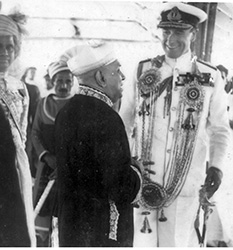
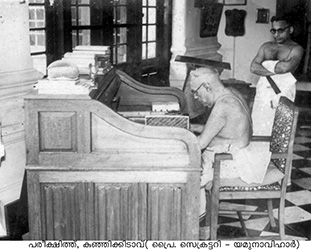
.jpg)
This was the only Raja with whom I was lucky to interact on a personal basis. I was barely 20 years old, yearning to study Medicine. But my Mother and her sisters with their intense orthodoxy objected to this idea of mine. My Father suggested that I approach my eldest uncle for his support which he readily gave. My eldest uncle, Vallia ammaman, asked me to visit the Maharaja , my grand uncle. The prospect of a personal visit with such a great man gave me a lot of anxiety and worry. Yet, I gathered enough courage and went to the Hill Palace. There I met His Highness’s private secretary ( who was a cousin) who escorted me to meet him and put me at ease. His Highness was very kind, applauded my decision and totally endorsed the idea. Moreover, he suggested that I visit him every year and share my experiences with him. Indeed I did that and cherish those memories. I could not meet him after graduation because he passed away just prior to that in 1964.